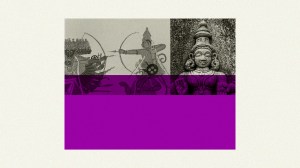In this series


(This is the second in a series. Here’s the previous episode.)
Hindu worship has so many variants that it seems endlessly confusing to many outside the faith. Scholars attempt to classify, but each has a different systemization: Some speak of three traditions, some four, some six, some more.
Maybe the most popular tradition is Vaishnavism, centered on devotion to Vishnu, who takes human form and comes to the rescue of those devoted to him. Hinduism’s two most beloved epics, the Mahabharata and the Ramayana, are the stories of his incarnations as two avatars in particular, Krishna and Rama.
The Mahabharata saga introduces the Kaurava family: 100 sons, 1 daughter, and a deep hatred for the Pandavas, their cousins. At the conclusion of a high-stakes dice game, the Kauravas cheat, claim all the Pandavas’ wealth and land, and drive the Pandavas into the forest. Thirteen years later, the Pandavas try to reclaim their land, and a war begins.
Krishna, who appears to be the king of a nearby region but is actually an incarnated Vishnu, tries to be a peacemaker but cannot overcome the power of inflamed relations. When war seems inevitable, Krishna gives the two camps a choice—one can have his impressive army, the other his guidance. The Kauravas, believing in man’s strength, choose the army. The Pandavas, who know Krishna’s real identity, choose superhuman wisdom. Krishna becomes the chariot driver of Pandava leader Arjuna.
With the battle about to begin, Arjuna becomes so dismayed at the thought of killing his relatives and friends in the other army that he refuses to fight and throws away his weapons. But Krishna tells Arjuna he is deluded to be laid low by such transient concerns, and instructs him to fight. Arjuna agrees, and the Pandavas overcome the numerical advantage of the Kauravas through Krishna’s advice.
The advice includes breaking an ancient rule in single combat between each army’s designated battler: Don’t use a mace below the waist. Bhima of the Pandavas is losing to brutal Duryodhana of the Kauravas. Krishna gestures: the thighs. Bhima makes the kill shot. Another Pandava victory comes by Arjuna using a woman as a human shield against Kaurava general Bhishma, who has vowed never to fight a woman. Arjuna has time to shoot his arrows. Bhishma dies. So do thousands of others.
What about all those corpses? The poetic conversation between Arjuna and Krishna makes up the Bhagavad Gita (“Song of the Lord”), the most-read part of the Mahabharata. Krishna tells Arjuna, “You grieve over those who should not be grieved for. … Wise men … do not sorrow over the dead or the living”—since souls transmigrate from one body to another and eventually become part of the cosmic whole.
The Ramayana, also well-known, has as its hero Rama (as in the chant ‘Hare Rama, Hare Krishna,’ with hare (pronounced har-EE, two syllables) referring to energy that can be both intellectual and sensual). The story is that Ravana, the tyrannical ruler of Lanka, persecutes righteous Hindus. Vishnu comes to earth as one of his avatars—Rama, son of a northern Indian king. His goal is to show mankind the importance of upholding dharma.
Rama’s charm, humility, and friendliness make him a beloved prince, and he marries Princess Sita, also the child of a king and a superhuman incarnation. Rama’s old human father, Dasharatha, wants Rama to become king, but one of the king’s three wives has saved the king’s life and he has promised to grant her two requests. Her requests turn out to be that her son become king and Rama be banished to the forest. The king’s promises bind him. Rama, upholding dharma, does not complain but heads immediately into exile, with Sita accompanying him. The old king dies of grief, and Rama heads south, where persecution rages.
Rama, Sita, and their friends spend 14 years living ascetically in southern India, during that time fighting and winning several wars with the tyrant Ravana and protecting good Hindus from persecution. Ravana battles back by kidnapping and imprisoning Sita with the goal of having sex with her—but she, hardly eating anything, meditates on a rescue by her husband. Lust-blinded Ravana keeps trying, but Sita becomes a symbol of chastity and devotion.
Rama comes to the rescue and has his small army attack Ravana’s mighty force. After a terrible war, Rama single-handedly defeats the enemy army and kills Ravana, thus ending the suffering of devout Hindus. Like the Mahabharata, the Ramayana shows that the duty of a royal hero is to preserve and develop harmonious social order—dharma.
If that seems hard, don’t worry, Hindus say: Vishnu has a wife, Lakshmi, which literally means “she who leads you to your goals.” She functions as a mediatrix between Vishnu and his devotees, serving as a provider of fertility, wealth, and prosperity. Lakshmi is a favorite among merchants and others engaged in business pursuits. In colloquial Hindi, people often use Laksmi and the word money interchangeably.
The second-most-popular Hindu tradition is Shaivism, worship of Shiva, who has 108 names in all. He is often called “the destroyer,” but some interpreters see this as creative destruction—getting rid of obstacles to spiritual development. Scholars debate the origins of Shaivism: Most consider it an amalgam of ancient cults. Shaivism is also the part of Hinduism that emphasizes what has become its most popular American practice: yoga.
Like Vishnu, Shiva has a wife, Sati. She marries Shiva against the wishes of her father, who then humiliates her. She burns herself to death to protest and to uphold the honor of her husband. Grief-stricken Shiva carries her corpse around the world and performs a celestial dance of destruction until other deities ask Vishnu to stop it. Vishnu shocks Shiva out of his anger by cutting the corpse into 51 pieces. Sati is then reincarnated as Parvati, Shiva’s second wife.
The third-most-popular Hindu tradition is Shaktism, which holds that feminine energy is ultimate reality and which worships ten superhuman females, including Vishnu’s wife, Lakshmi; Shiva’s second wife, Parvati; Saraswati (patron of learning and inventor of Sanskrit); Tripura Sundari (the most beautiful woman across the three realms of creation, preservation, and destruction); and Kali.
Kali is the most famous. She represents the realities of death and destruction but protects devotees who approach her with the attitude of a child. The most famous Kali legend, the Devi Mahatmyam, shows how the wounding of a demon makes things worse: Every drop of a demon’s blood produces a demon duplicate. Demons fill the landscape until Kali comes, dressed in tiger skin and carrying a sword and a noose. She consumes the clones and dances on the corpses of the dead.















